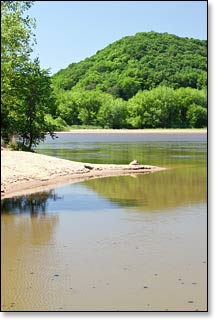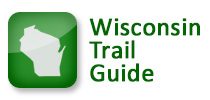Synopsis
Paddling the Lower Wisconsin River

The 92 miles of the Lower Wisconsin State Riverway, from Sauk Prairie to the Mississippi River confluence, is one of the most popular flatwater paddling rivers in Wisconsin, next to the St Croix and Namekagon Rivers. On the LWSR, canoers and kayakers will find a wonderful, flatwater paddling experience; with no dams and no rapids, this is one of the longest free-flowing, navigable stretches of river in the upper Midwest.
This entire reach flows through the 'Driftless Region', where the surrounding area was untouched by glaciers during the Ice Ages. Tall bluffs and steep hills with canopies of dense forests often overlook the riverway providing gorgeous scenery. However, the vegetation immediately surrounding the river can vary greatly; paddlers will float by dry sand barrens, high sandy banks, open prairie, oak savannah, hardwood forests, bottomland forests with dense underbrush, numerous sloughs, and occasional areas of open marsh.
Dozens of wooded islands populate the riverway, yet it is the slow-moving waters and hundreds of sandbars which develop in low to moderate flows that provide the strongest attraction for the several hundred thousand paddlers that visit the LWSR each summer. Other features of the LWSR include: easy shuttle routes; a large number of shuttle and outfitter services; numerous landings with free (overnight) parking; free camping on sandbars and islands; and no dams/portages, all combine to create a relaxing and enjoyable paddle experience with trips that can range from a few hours to several days.
The LWSR is home to an amazing amount of birdlife. Glide along the river's edge and you'll be surrounded by a veritable symphony of birdsong; among the aerie performers are numerous species of warblers, finches and sparrows. Other species that you may see include: cranes, sandpipers, ospreys, kestrels and turkey vultures along with several species of hawks. It is estimated that more than 250 species of migratory and 'permanent inhabitant' birds can be found along the Lower Wisconsin State Riverway.
Bald eagles have become much more common in the southern reaches of the Wisconsin River in recent years. You'll often spot these magnificent birds perched in tall trees along the riverway or soaring high overhead off one of the many bluffs overlooking the river.
Fishing is very popular as well. The river is well known for smallmouth bass, walleye and northern pike along with significant numbers of panfish such as crappie, bluegill, white bass, and rock bass.
The entire 92 mile stretch is flatwater, suitable for paddlers of all skill levels.
Please read the section titled 'River Hazards' at the bottom of this page before you paddle the riverway!
River Camping
Sandbar camping on the LWSR is an extremely popular way to enjoy the river. In fact, several local outfitters estimate that as much as 85% of their shuttle services involve overnight / multi-day river trips. Camping in groups is the most common, with several shuttle services able to accomodate group sizes up to 200 people.
The majority of overnight paddle trips occur in the upper reaches of the LWSR; between Sauk City and Spring Green (Segment LWSR1), with the 18.8 mile trip between Mazomanie and Spring Green being the most popular for overnight outings.
Check out the list of 'Paddlesport Shuttle Services / Outfitters' on the Local Business Directory webpage. Many shuttle services have websites with excellent information about canoeing and camping on the riverway.
“Camping is restricted to no more than 3 days on State owned islands and sandbars. Camping at these locations is restricted to persons and their equipment arrived by watercraft only. A camping permit is not required.”
from Wisconsin DNR
Camping at nearby Wisconsin State Parks
Several of the most scenic Wisconsin State Parks are located within easy driving distance of the river at various points. Two of the parks are located along the riverway: Tower Hill in Segment LWSR3, and Wyalusing in Segment LWSR4. Most of the parks feature family campgrounds and numerous outdoor recreational opportunities. See the Local Business Directory webpage for a complete listing. In addition, each of the segment webpages in this guide will have links to make camping reservations at the State Parks nearest to that particular segment.
Lower Wisconsin State Riverway Board
The 92 mile section of the Wisconsin River below the Sauk Prairie Canoe Landing lies within the boundaries of the Lower Wisconsin State Riverway, a State Natural Area which can be best described as follows:
"The Lower Wisconsin State Riverway was enacted in 1989 [called a different name at inception], the project seeks to protect and preserve the scenic beauty and natural character of the river valley, seeks to manage the resources of the area for the long term benefit of the citizens of the state and seeks to provide a quality public recreational area in a manner consistent with the resource and aesthetic protection goals and objectives. The agency responsible for assuring scenic protection of the valley is the Lower Wisconsin State Riverway Board, a nine person citizen board with headquarters in Muscoda..."
"...Administration of the Riverway regulations and protection of the resource is very much a cooperative endeavor. While the board is responsible for the scenic protection regulations, the Department of Natural Resources (DNR) is responsible for resource and recreational management issues and land acquisition. In the shoreland and floodplain zoned areas, each Riverway county administers local zoning ordinances which require minimum setbacks for buildings and limits on the amount of woody vegetation which may be removed. A partnership has been established between the board, the county zoning administrators and the DNR to assure the goals of the Riverway are achieved and the responsibilities of the respective jurisdictions are met. Much of the success of the Riverway is the result of the cooperation between these governmental entities..."
"...The Riverway law is indeed unique and innovative and is another example of the proud tradition of resource protection in Wisconsin. With the law in place, the people of Wisconsin are assured that the beauty and biological diversity of the river and its valley will remain for generations to come. With the continued sound stewardship of the land by private property owners, the effective and thoughtful management of the resource by the DNR and local authorities, and, with the scrupulous administration of the aesthetic protection regulations by the Riverway Board, the Lower Wisconsin State Riverway will remain one of the gleaming jewels in Wisconsin's natural resources crown..."
Preceding excerpts taken from the LWSR Website, Project History.
Written by Mark E. Cupp, Executive Director
Lower Wisconsin State Riverway Board
Season
The river is usually navigable throughout spring, summer, and fall. It can be scrappy in places during periods of little rainfall in summer and fall. Paddlers should avoid the river in early spring, whenever water levels are very high.
River Level Information
River Gauge Location: State Hwy 80 Bridge at Muscoda
USGS Website: USGS Gauge @ Muscoda, WI
Phone Contact for River Info: Contact local shuttle service / livery (see Local Business Directory page).
Always check the local weather forecast before paddling on the LWSR. Also, even if the local forecast calls for sunny conditions, talk to a local outfitter about possible river surges before embarking on an overnight trip! Although it may be sunny in the LWSR, any kind of heavy rainfall upriver can result in an unexpected rise in river levels. Although this set of conditions doesn't happen very often, it occasionally does, and is something to be aware of.
Suggested River Levels
| Below 4,000 cfs |
Very shallow riverway, many large sandbars. You may have to step out and push several times. Excellent conditions for sandbar camping! |
| 4,000 cfs to 10,000 cfs |
Normal summer conditions, many medium to large-sized sandbars. Shallow riverway at low end of this range - occasionally, you may have to step out and push. Excellent conditions for sandbar camping! |
| 10,000 cfs to 14,000 cfs |
Above normal flow conditions, noticeable undercurrents developing, especially in lee of sandbars and islands. Sandbars are smaller and fewer in number at high end of this range. Usually acceptable conditions for sandbar camping. |
| 14,000 cfs to 17,000 cfs |
High flow conditions. Undercurrents above 4 mph develop, especially in lee of sandbars. Sandbars are few in number. Sandbar camping not recommended in this range. |
| 17,000 cfs to 20,000 cfs |
High flow conditions with deceptively powerful undercurrents developing. Overnight camping on sandbars and beaches not recommended! Can be a fun day trip however, many small channels open up in lower reaches of the LWSR - be careful of strainers in narrow confines. |
| Above 20,000 cfs |
Paddling not recommended! |
River Hazards
The Wisconsin River is in a constant state of transition. Consider the evolution of a sandbar of which there are hundreds at any given time. First a sandbar is created, then reshaped, then shifted, then swept away, while another mysteriously appears nearby and undergoes the same metamorphosis. The same can be said for the river channel, which often shifts, splits and then rejoins itself again and again. And, to make it even more interesting, the river does not move at a constant speed at all! In fact, it often fluctuates as it runs its' course, from less than 1 mph to more than 5 mph.
Shifting sandbars, a moving river channel, and dynamic rate of speed are a few of the contributing factors to a couple of hazards paddlers need to be aware of. First are sudden dropoffs, where the river can go from a few inches deep - to several feet deep in one step. Second are 'layered' currents, where the current can appear to be slow on the surface but will be fast and powerful enough to sweep your feet from under you just a few inches below. Both hazards are especially common in the lee of sandbars and islands, places where you should never wade! When you do wade into the river - say off a sandbar - make sure you do it near the 'head' or 'up-river' side, and try to have your feet and knees pointing up-river. Remember to always wear a pfd! (personal flotation device)

